Lightweight Precast Building Envelopes Maximize Performance
Resilient and lean, fiber-reinforced modular precast wall systems maximize thermal performance, minimize construction scheduling, and produce buildings that meet the highest sustainability standards
April 2020
By Celeste Allen Novak, FAIA, LEED AP, BD+C
 Continuing Education
Continuing Education
Use the following learning objectives to focus your study while reading this month’s Continuing Education article.
Learning Objectives -
After reading this article, you will be able to:
- List manufacturing and technology advances that are streamlining modular precast concrete wall enclosures.
- Discuss the components of lightweight modular precast concrete wall systems that contribute to high-value green building rating systems.
- Identify thermal requirements of a manufactured wall system that provide continuous insulation and thermal gap protection in all climate zones.
- Compare a variety of buildings designed to take advantage of lightweight modular precast wall systems in projects that range from renovations to new construction and traditional to modern design.
A dramatic LEED-certified high-rise office in Coahilla, Mexico, the Insignia de Saltillo is composed of 718 skewed parallelograms. Ironically, this building unites the most recent advance in lightweight precast panel technology with a facade designed to emulate the interweaving of fabric banners of the Middle Ages. From the building of the aqueducts to the construction of skyscrapers, advancements in technology and manufacturing processes have made concrete and subsequently precast concrete panels some of the most versatile materials on the planet.
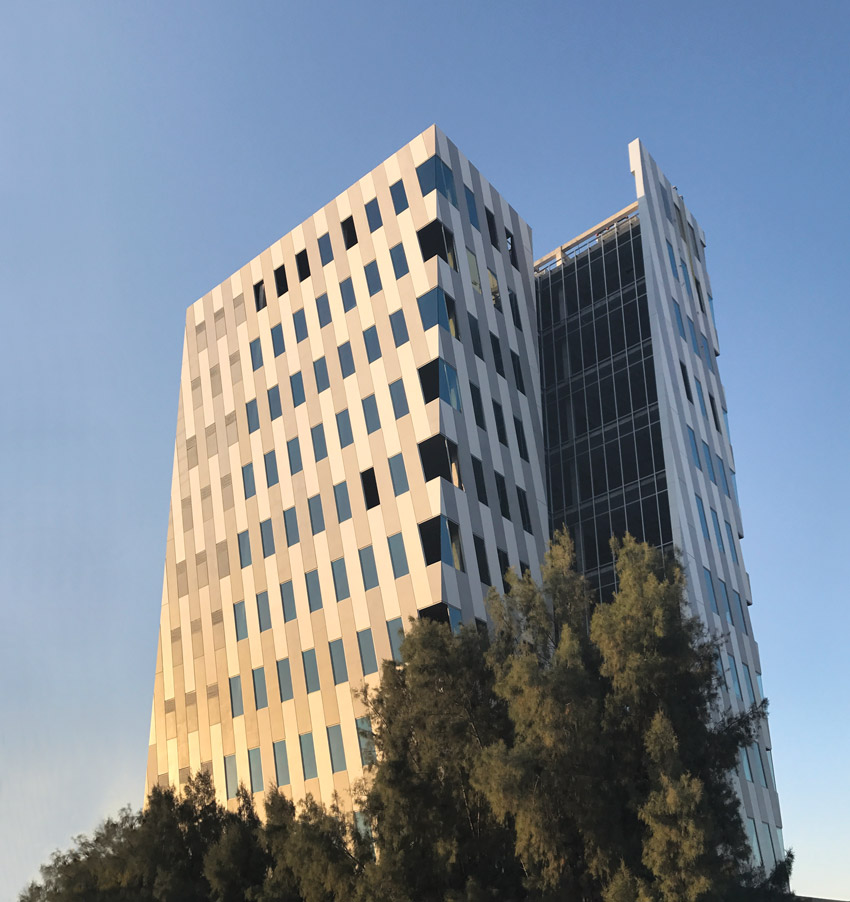
© Opticretos
The Insignia de Saltillo designed by Cuatro 44 Architecture is the first LEED-certified building in Coahilla, Mexico. The 718 skewed parallelograms provide an energy-efficient facade composed of lightweight precast concrete panels.
Driven by the demand for new housing in the 1940s and 1950s, European engineers developed a method of precasting concrete into panels modularized and built in factories as an economical means to faster and more durable construction. By the 1970s, insulated concrete sandwich panels were a common part of a contemporary architect’s design palette. They were a go-to material for economical load-bearing walls in housing and commercial buildings. As manufacturing and technology advances began to lighten panel enclosures, composite thermal panels were developed to meet new demands for energy efficient buildings.
According to Art Miles, president of Easi-Set Worldwide, “Off-site prefabrication and modularization of lightweight composite precast facade assemblies has revolutionized the building construction process. They provide solutions that deliver maximum value to owners by integrating design optimization, financial savings, factory-controlled quality, improved site safety, higher energy performance, and ecofriendliness that fit squarely into the lean building model.” While architects were searching for building materials that met green building performance ratings, manufacturers were also investing in efficient ways to build lighter, stronger buildings that reduced waste. By the 1990s, many manufacturers began to implement lean manufacturing processes striving for ways to streamline construction. Manufacturing and technology advances are part of the story as to how “heavy” precast building systems became the streamlined modular precast wall enclosures used in sustainable buildings today. In addition to the increased use of technological solutions and industry advances, architects are adding value for owners by using an integrated design process. This process includes the early coordination of design aesthetic, performance, and scheduling goals with contractors and material suppliers.
Within the past 20 years, innovative architectural precast designers began to look at ways to make panels lighter (e.g., removing the 4 to 6 inches of structural concrete behind the 2 inches of architectural precast face mix). They have incorporated in its place functional features (e.g., perimeter framing, insulation, and drywall ready) while maintaining the ability to introduce reveals, projections, and true brick finishes. These lighter panels could also be made larger, thereby reducing the number of loads shipped to the site and speeding building envelope completion. Additionally, the movement toward off-site manufacturing in a controlled environment reduced site construction costs, reduced waste, and improved cladding quality. Another benefit of these lighter-weight panels is that they can also be used to reclad existing buildings using the as-built foundation and superstructure.
Industry has invested in the development of turnkey products that dovetailed into the concept of energy and waste reduction and the economical and efficient use of materials for the green building movement. “Reduce, reuse, and recycle” has become a design and engineering criteria for building materials. Over the past 20 years, The American Society of Heating, Refrigerating and Air-Conditioning Engineers (ASHRAE) has published increasingly stringent energy standards that require energy modeling and continuous insulation. These standards are embedded in the International Energy Conservation Code(IECC) and used as a criteria for many regulatory agencies as well as green certification programs. ASHRAE 90: Prescriptive Wall Insulation Requirements prescribes “insulation that is continuous across all structural members without thermal bridges other than fasteners and service openings. It is installed on the interior, exterior, or is integral to any opaque surface of the building envelope.”1 Off-site, factory-controlled materials are key to meeting ASHRAE standards and can provide financial and environmental benefits to project teams. Protecting the environment while conserving resources is embedded in today’s lean manufacturing. Panelized lightweight precast concrete panels are part of a growing industry of efficient, sustainable building systems made possible by 21st century technology.
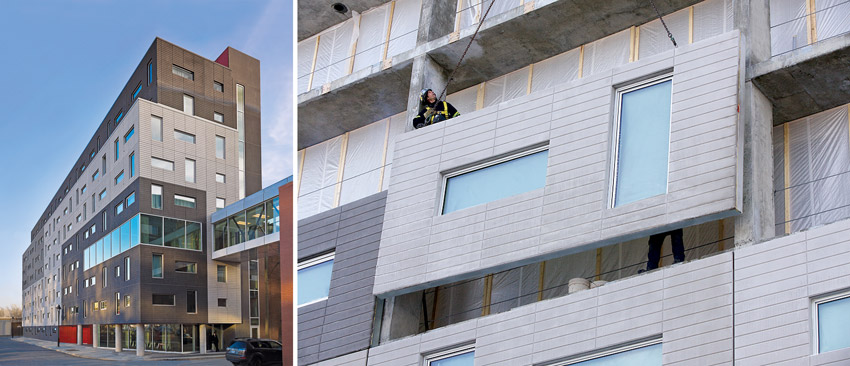
© Serge Jacques (left); © BPDL (right)
The ÉTS School of Technology Student Residence in Montreal, Canada, was developed jointly by the ÉTS construction and operations teams, architects Régis Côté and Associates, structural and civil engineers Pasquin St-Jean and Associates, and electromechanical engineers Beaudoin Hurens. The general contractor Groupe Decarel met a fast-track, 18-month deadline by installing factory-assembled, lightweight precast concrete panel systems complete with windows, thermal enclosure, and perimeter framing as part of the LEED Gold application.
A lightweight precast concrete sustainable wall enclosure provides thermal efficiency, minimizes waste, increases performance, and streamlines the construction process. New composite systems are developed with the aid of high-tech digital fabrication systems and the direct exchange between architects and manufacturers to ensure design integrity. These precast concrete panel systems are built in temperature-controlled factories with digital tools that measure and monitor thermal performance to meet The International Energy Conservation Code thermal requirements from zones 1 through 7.
New wall systems include 2-inch concrete enclosures developed to match traditional as well as modern aesthetics. They can weigh up to 60 percent less than traditional precast wall systems. These concrete precast walls are modularized to include the facade, moisture/air barriers, insulation, and, in some examples, windows and interior framing. The complex wall enclosures designed for the 10-story Insignia corporate offices in Mexico and the ÉTS School of Technology Student Residence in Montreal, Canada, demonstrate the wide array of performance values that can be achieved in both northern and southern climates.
A performance study of the BioInnovation Center in New Orleans provides even more details of how lightweight precast concrete systems meet the demands for stringent aesthetic and green building standards.
Strategies that maximized performance for the New Orleans LEED Gold BioInnovation Center included the choice of a high-performing, lightweight modular precast concrete wall system designed to meet LEED Gold standards.
Engineering Value: Reduce, Reuse, Recycle
As engineers and manufacturers continue to drive for excellence, they are using new manufacturing and technology advances that streamline modern precast concrete wall enclosures. Value in construction materials can be achieved in many ways. Building enclosures are complex systems. The life of a building depends on the durability of its enclosure. Appearance, thermal control, moisture mitigation, structural strength, and constructability are some of the main areas that a design team will investigate when selecting materials for a building enclosure.
Lighten the Load
The components of lightweight precast concrete panels maximize the durability of concrete while lightening the load of this versatile material. Computerized equipment controls and digital fabrication have modernized and simplified the creation of new materials. Hybrid lightweight precast panels weighing as little as 28 pounds per square foot may combine the following materials:
- 2-inch architectural precast concrete with integral water repellent in a wide array of finish, color and texture options.
- Polyvinyl alcohol (PVA) reinforcement fibers dispersed throughout the concrete to form a molecular bond with the concrete. This reduces crack formation and provides multidimensional reinforcement. They also improve the concrete’s resistance to impact, shatter and abrasion.
- Lightweight wire mesh to increase structural performance.
- Precise variable air spaces (½ to 2½ inches).
- Vapor barrier placed in the appropriate location for climate control.
- Continuous insulation installed in controlled conditions and guaranteed to meet required energy codes.
- Galvanized steel-stud frame (4 and 6 inches).
- Firestopping.
- Windows properly flashed as part of a complete wall assembly.
- Interior framing drywall ready.
Lightweight precast concrete panels are 66 percent lighter than traditional architectural precast wall systems. The factory control of design elements and on-time delivery methods provide surface protection as well as thermal control.
Larger panels are provided for delivery to construction sites, complete with windows, insulation, thermal breaks, and interior finishes supporting faster and more productive construction schedules.
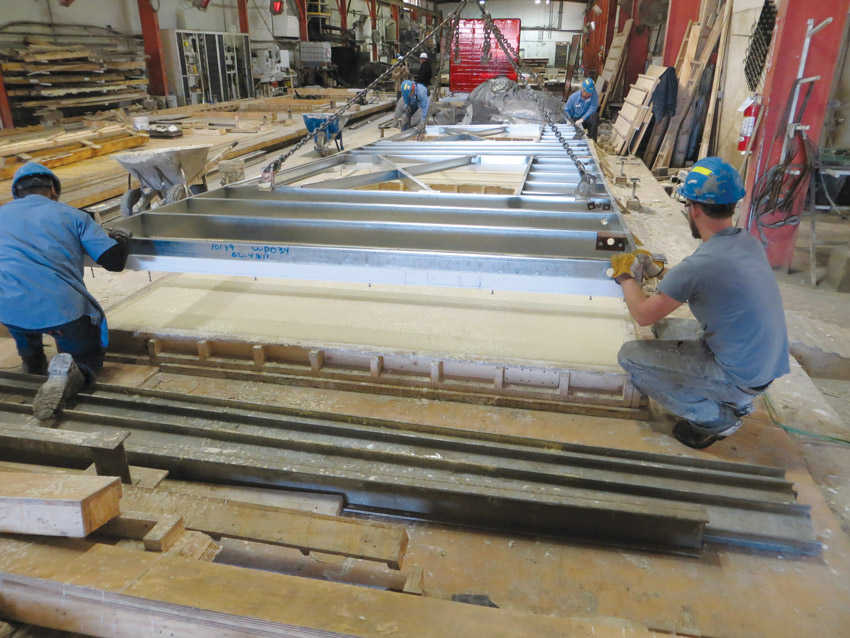
© Smith-Midland Corp.
Manufacturers can guarantee structural and thermal control with factory-built panelized enclosures that control the random factors that impact field installation.
Thermal Control
The use of an array of energy modeling programs and the ability to track performance data from similar building types across the United States allows architects and engineers to meet even net-zero energy use in buildings. Coordinating sophisticated thermal performance requirements with manufactured products is changing the marketplace.
A well-insulated thermal enclosure must attain the appropriate U-value recommended for the project climate zone. In addition, a complete enclosure meets the desired acoustic control of the interior, particularly when meeting LEED for Schools Acoustical Control Performance. The goal is to achieve continuous insulation across the entire enclosure that can be assured through factory production.
Thermal and acoustic performance is impacted by gaps that often occur during on-site installation between precast exterior skin and the steel frame, improperly attached air and water barriers, and thermal bridging from improper window or sunscreen attachments. A factory-built panelized enclosure system controls the random factors that impacts field installation. Manufacturers guarantee structural and thermal control, meeting engineers and architects’ criteria through extensive testing.
The American Society for Testing and Materials (ASTM) develops and publishes technical standards for a wide range of materials, products, systems, and materials. ASTM C1363-11 measures thermal performance of panels using a hot box. The objective of this test program is to investigate how standard insulated lightweight precast concrete panels could meet the 2012 International Energy Conservation Code (IECC) thermal performance requirements for all climate zones within the United States and parts of Canada. The test is performed on exterior panels containing varying depths of different closed-cell foam insulations and gap “spacing” (the gap between the precast concrete exterior skin and the steel stud frame). These separate tests provided the foundation for developing a methodology to ensure that the panel’s thermal performance (U-value and continuous insulation) will meet varying client requirements. Factory-built wall systems can be calibrated to meet this standard. The test is a measured result vs. a calculated value of the wall system.
Moisture Mitigation
In any climate zone, the impact of water, moisture, wind-driven rain, and vapor migration requires a building that breathes. Even the most carefully detailed building may succumb to early structural failures due to improper installation of materials designed to control moisture. Engineered lightweight precast concrete panels are detailed with integral water repellent, continuous vapor barriers, rainscreens, and air spaces placed within a wall cavity designed for the weather. All of these components are factory installed to provide a complete wall system that will respond to the weather and climate at its site location. Street-level leak-detection caulking systems comprised of calibrated drain strips, appropriate sealants, and a water-detection weep designed for the system are installed on-site after the panels are in place.
Material Sustainability
When working on a project that is targeting LEED credits, designers can earn up to six points in this LEED category. For example:
- Construction Waste Management, Materials, and Resources: Rewards points for the diversion of construction debris from disposal in landfills. A prefabricated precast concrete wall system is constructed in an off-site plant and assembled on-site with precut steel and precast concrete. There is virtually no on-site waste associated with wall construction.
- Recycled Content, Materials, and Resources: Rewards the use of materials with recycled content. Recycled materials can be a large component of the lightweight precast concrete wall systems. Architects may specify recycled material in the entire assembly of the panel, concrete, steel, and insulation. The controlled factory environment including supply monitoring and measuring will provide data as to the exact amount of recycled content in the assembly.
- Regional Materials, Materials, and Resources: Supports the use of indigenous (local) resources and reduced transportation distances. The components of these systems are common materials. Panel manufacturers typically use locally sourced materials, and lightweight precast panel manufacturing facilities are often located within 500 miles of project sites across the country. Most design professionals can select the raw materials of lightweight precast wall panels locally or within the 500-mile prescribed radius of project sites.
Most sustainable design architects will attest that their goal is to not count points but to achieve buildings that do no harm to the environment. A lean, turnkey construction process with thermal and material advantages adds many benefits to a designer’s toolkit.
Exemplifying Strategies for Sustainable Success
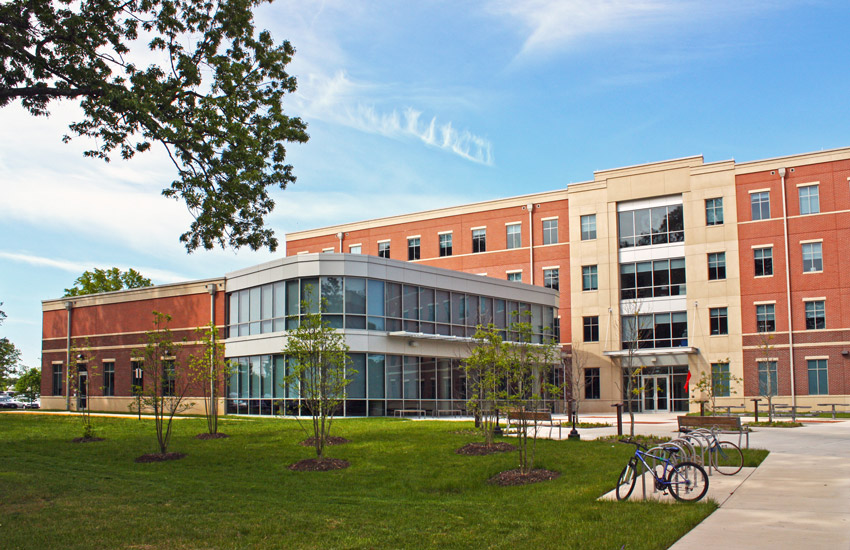
© SlenderWall by Easi-Set
By selecting a precast concrete cladding with a brick veneer finish wall system, the design team for the U.S. Army Legal Services Army Command Center at Fort Belvoir, Virginia, eliminated the need for four separate trades while meeting LEED targets.
Army Strong, Green, and Lean
A study of the Federal U.S. Army Legal Services Army Command Center at Fort Belvoir, Virginia, provides an example of how the use of lightweight precast concrete panel systems can speed up a project schedule while reducing project costs. The BRAC 132 Army Administrative Facility was envisioned as a building that would “express the permanency of the court system and the high ideals to which the military legal system adheres,” according to Andrew Rashid, Perkins+Will’s science and technology market leader, Washington, D.C. However, the building also needed to meet a fast-track 12-month schedule that would be difficult to meet using traditional building materials. By selecting precast concrete cladding with a brick veneer finish, this wall system eliminated the need for four separate trades while meeting LEED targets.
The U.S. Army has a serious commitment to building green buildings. Since 2001, the Army has been building energy-efficient, sustainable buildings. The U.S. Army Corp of Engineers LEED v4 Implementation Guide can be found online, and it details stringent requirements for new facilities, major renovations to existing buildings, and family housing.4
The team looked at ways to boost productivity and reduce waste while ensuring a high level of workmanship and quality, according to Chris Seveney of Suffolk Construction. “A project like this would typically carry a delivery schedule of 24 months, but it was given a congressionally mandated completion date of one year,” he says. “It was essential that the team use as many lean design and construction practices as possible.”
Lean design and construction management processes included the integration of all project team members, including the material suppliers and utilizing building information modeling (BIM) during all stages of the project.
The team chose to use a composite exterior panel system that allowed the contractor to enclose the 33,338-square-foot building in 14 days. The lightweight precast concrete panel combined a precast exterior panel with an integrated perimeter stud-wall system. The cladding was formed to match the local brick finish. Panel sections up to 26 feet wide and 10 feet high were installed with punched window openings. Filled with closed-cell foam insulation at 3.5 inches deep, the 169 discrete panels would also deliver high thermal performance of R-21 with a continuous air and moisture barrier.
The building also needed to meet strict blast resistance criteria. “The selected wall system was designed to meet the strict anti-terrorism criteria for security and blast resistance as required for all new government buildings by the federal departments of Defense and Homeland Security,” reports Matthew Smith, vice president of sales and marketing for Smith-Midland, the precast subcontractor. “Yet it is a lightweight method of only about 30 pounds per square foot, mounted outboard of the floor slab.” According to Smith, “Lean construction is a movement” that soon will be adopted widely as project teams search for more ways to build quickly and cost effectively while still retaining excellence in design.
“This project shows how the federal sector can think lean and smart in future projects,” says Heidi Perham, NCARB, AICP, managing director with BCRA, the interior design firm for the project. The building achieved LEED Gold status as well as the Best Lean Construction Award from the Associated General Contractors. Materials matter when employing more sustainable, lean construction techniques.

© SlenderWall by Easi-Set
Architects Ayers Saint Gross employed high-tech analysis to over-clad the existing facade at the Nelson-Harvey Building at the Johns Hopkins Hospital in East Baltimore with the use of lightweight precast concrete panels. The client required that construction allow for occupancy on the first two floors as well as access to the rest of the hospital.
Medical Insertions
With surgical precision, the Ayers Saint Gross design team analyzed and resolved the unique challenges of the over-cladding of the 1970s the Nelson-Harvey Building at the Johns Hopkins Hospital in East Baltimore. Its patient was an aging nine-story building with a sound structure in the middle of an extremely tight site. The team provided a resilient response that did not include the demolition of the hospital.
Using digital tools to analyze the displacement of the existing brick facade, the team collected data from 37 different locations over a two-day period to construct a three-dimensional model in Revit. It incorporated cloud measurement data into the BIM model to illustrate the variances in the wall plane accurately. With an accurate virtual model, the team was then able to test alternatives for a new thermal skin as well as stage construction on this tight site.
The technical challenges included the development of an exterior envelope that met Baltimore City Green Building Standard.5 Although based on the LEED process, a Baltimore Green Building Rating certificate or plaque is only granted after the Construction Code Enforcement inspectors have verified their observations through site visits during the construction phase and prior to issuing a Certificate of Occupancy. In addition to maximizing thermal performance, other project goals included:
- The use of masonry as predominant cladding material to complement the existing adjacent buildings;
- The installation of a 21st century air and water barrier into the new building skin;
- New fire/smoke containment to enhance building resiliency;
- Limiting cladding system weight (5 percent dead load threshold for steel structural members, 10 percent building lateral);
- An aggressive design and construction schedule;
- Maintaining occupancy of lower two floors and ensure access to entire facility during construction; and
- Minimizing the noise and dust of construction disturbance to hospital operations.
The installation required meticulous coordination, scheduling, and timing. The envelope strategy included “recycling in place” of the existing masonry. A new structural frame was installed to the existing structure that supported new lightweight insulated precast panels. Steel anchors were “needled” into the existing walls through to the steel frame. Engineers compartmentalized new and existing horizontal cavities in the exterior walls to prevent stack effect. The new facade was a combination of a high-performance glazed aluminum curtain wall with aluminum louvers and insulated panels, along with lightweight precast concrete panels.
The 158 panels that spanned from floor to floor and column to column weigh 28 pounds per square foot, allowing installation without the removal of the existing facade. Fully insulated panels were lifted into place by small cranes and insulation was also added between panels after erection to provide continuity. The entire system depth was an overall 8½ inches and included a 2½-inch thin-brick mechanically bonded to a lightweight concrete panel on 6 inches of cold-formed metal framing (CFMF).
According to the design team, prefabrication reduced waste by the use of off-site fabrication of lightweight precast concrete panels. The careful installation process reduced demolition, avoiding 2,130 tons of masonry hauled in 71 trucks that also decreased airborne noise and dust for occupied buildings. The existing cladding was measured at a weighted average of R-9.61. The new cladding with the over-cladding increased performance values by 227 percent, measuring a weighted average of R-31.44.
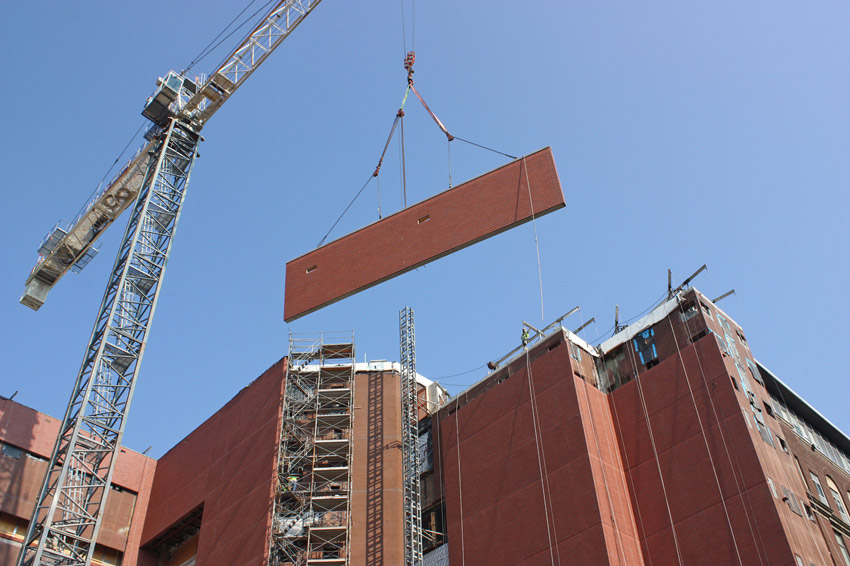
© SlenderWall by Easi-Set
Lightweight concrete panels were lifted in place using equipment designed for this tight site footprint. The architects, engineers, and contractors worked together with the panel manufacturer to meet a just-in-time schedule for panel delivery and installation.
Resiliency has become a new target for sustainable designers. This term implies that buildings will meet demands of change, whether technological, behavioral, or climate driven. The architects at Ayers Saint Gross have demonstrated a new methodology for approaching the challenges for aging building portfolios that takes advantage of the benefits of modern, lightweight, factory-controlled, panelized construction materials. More details are available in their presentation, “Over-Cladding for Thermal Performance and Building Resiliency,” which is documented online.6 The improvements in performance, energy conservation, moisture mitigation, and aesthetics provides a sustainable 21st century lifeline for this aging campus.
Residential Timesaving High-End Finishes
The applications of precast concrete panels were both innovative and revolutionary in the development of the housing stock in the 1950s. Today, another material revolution is occurring, meeting another growing need to provide buildings for a growing hospitality and housing market, which includes both student and senior housing.
Lightweight, Modern Thermal Enclosure
Kaczmer Architects is familiar with the specification of traditional precast concrete panels for use on client projects. The firm has completed numerous projects for the internationally famous Cleveland Clinic, a campus of more than 40 buildings. It was selected to design the Holiday Inn Hotel to provide housing for patient families on the site of a former guesthouse. The Cleveland Clinic provides design standards for all of its buildings, which specifies materials from door hardware to exterior finishes and performance standards from BIM drawings to fire-protection materials. These standards include information on energy modeling and performance testing for all building enclosures.7
“White everything,” is the shorthand Dave Kaplan, project manager for work on the hotel’s exterior facade and its detailing, uses to describe these guidelines. He adds that modernist touches, such as incorporating glass curtainwall and wood interior-trim detailing, also can be incorporated. “They have a very simple color palette that we have to adhere to.”8
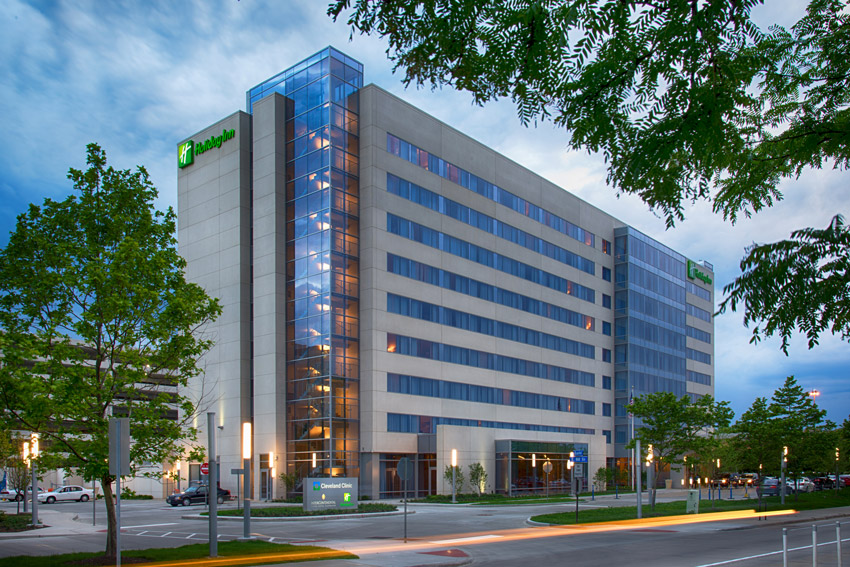
© Terry Wieckert/SlenderWall by Easi-Set
Kaczmer Architects chose a lightweight precast concrete wall system that included a modern white surface, insulation, vapor barrier, and interior wall framing for The Holiday Inn Hotel at the Cleveland Clinic.
Integrating design with construction evaluation, the entire team realized that it needed an alternative to the use of heavier precast systems that required a longer construction schedule to meet its budget and schedule requirements. The team designed a building with traditional architectural precast used at ground level with matching modular panels above. It chose a lightweight precast concrete wall system that included the smooth, modern surface, insulation, vapor barrier, and interior wall framing. The team was able to control the surface appearance in the factory and meet the energy standards as specified by the Cleveland Clinic. According to Kaplan, the manufacturer of this economical all-in-one wall system was “able to point me to UL assemblies they’ve used on other projects.” as well as take “care of the energy code.”9
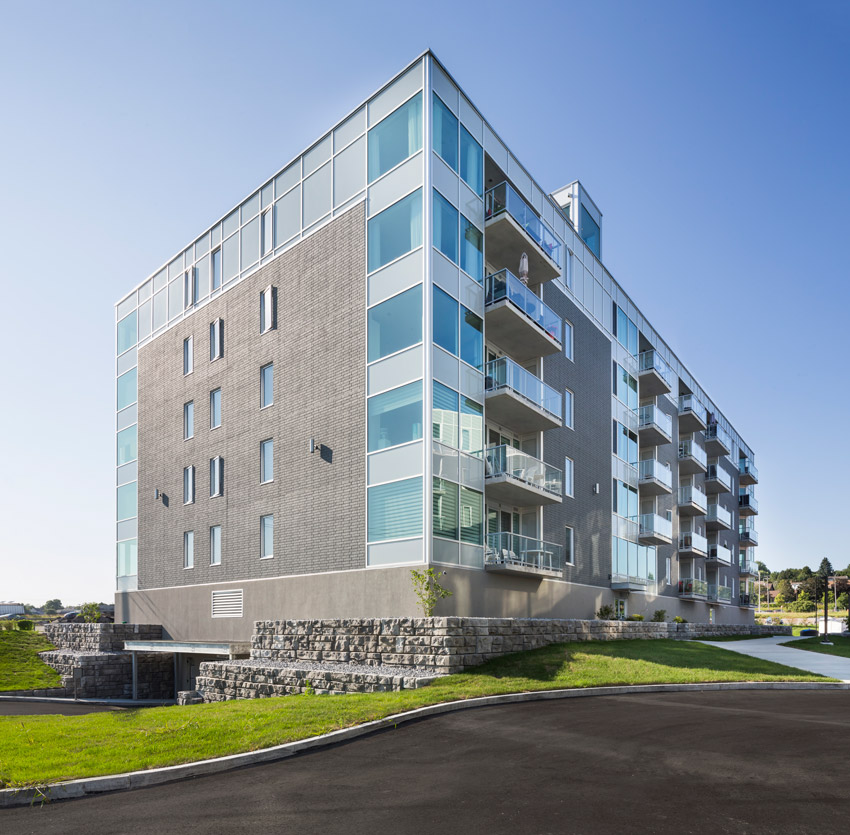
© Stéphane Groleau
Logisbourg, an award-winning Canadian real estate company selected a technologically advanced precast wall system for the contemporary five- story Luxembourg III, a luxury apartment in Quebec City, Canada.
Ease of Assembly
The competitive rental market is another area where design professionals are employing fast-track, turnkey building processes. Even in the luxury market, design professionals are turning toward the use of lightweight precast concrete wall systems. Logisbourg, an award-winning Canadian real estate company selected a technologically advanced precast wall system for the contemporary five-story Luxembourg III, a luxury apartment in Quebec City, Canada. “We are one of the only companies that build like this in Quebec City and maybe the entire province,” says Logisbourg project manager Jean-Simon Généroux, explaining how quickly prefabricated building systems can come together. “You know exactly what it’s going to cost and exactly how much time—it’s like LEGO blocks.”10
Located in climate zone 7, where average winter temperatures are measured in single digits, the wall system was designed to meet IECC thermal requirements. The panels were delivered with all of the windows preinstalled. Généroux affirms his belief that “installing the windows in the precast plant is a lot faster, and the quality is better.”11
Load-bearing lightweight precast concrete panels that included a vapor barrier, insulation, and interior framing studs were lifted into place and stacked on top of each other to form the shell of this five-story housing.
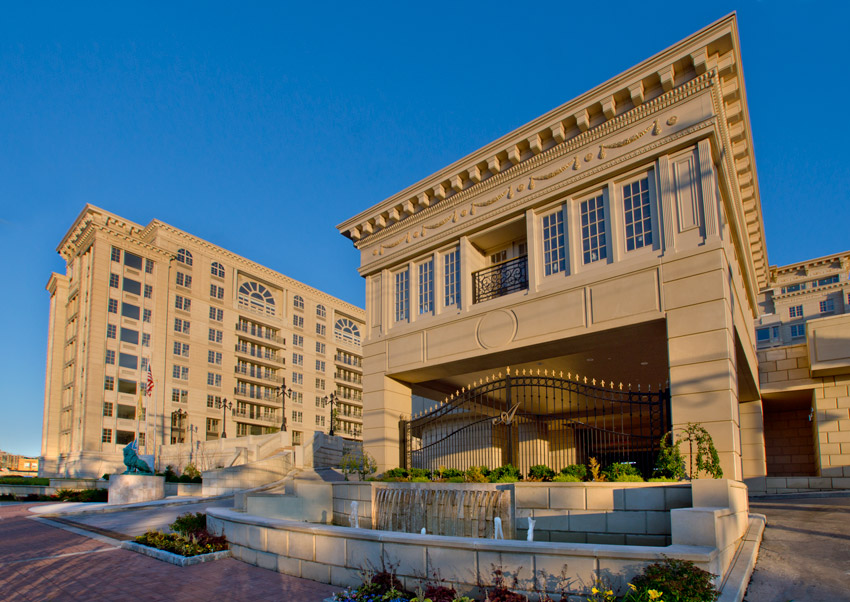
© SlenderWall by Easi-Set
The 19th century Manhattan architects would recognize the classic detailing of the Edgewater, New Jersey, luxury apartments, The Alexander on the Hudson, but they would be astounded by its construction using lightweight precast concrete panel systems.
Surface Protection
There is a demand for traditionally clad buildings as well as modern. In the past, architects who desired special surfaces might specify elaborate and expensive formwork to create the smooth or rough desired aesthetic. Computer-aided photo-engraving technology projects transfers and mills images to the formwork, board, or plastic. Today, architects can select from a wide array of affordable and unique finishes. Facades can be photo engraved, graphically animated, and, in the near future, embedded with solar cells. Design professionals can choose unique concrete patterns, recreate historic details, or select from smooth limestone simulations to rough surfaces with exposed aggregate. These concrete surfaces are built in controlled factory environments. Attached to a complete wall system, these narrow concrete exterior panels, identical in appearance, are then mechanically bonded to the framing system, avoiding the vagaries of weather, sunlight, and inadvertent damage by construction crews.
The classical Federal-style Park Avenue buildings in New York City of the 1940s and 1950s era are characterized by plain stone surfaces with narrow colonnades, panels, tablets, and friezes incorporated into the building facade. Although the 19th century Manhattan architects would recognize the classic detailing of the Edgewater, New Jersey, luxury apartments, The Alexander on the Hudson, they would be astounded by its construction. The building is constructed of lightweight precast concrete panels with a buff acid etched finish and historic details, such as the cornices, reveals, and bull noses. This classical facade incorporates a concrete-to-stud connection that isolates the exterior precast concrete cladding from the structural stresses associated with wind loading, material expansion, and contraction and seismic shock. At 30 pounds per square foot in comparison to the 80 pounds per square foot of traditional precast, 1,023 panels were designed to be LEED friendly. While replicating the past, the building advances the future with environmental and structural performance and lean constructability and scheduling.
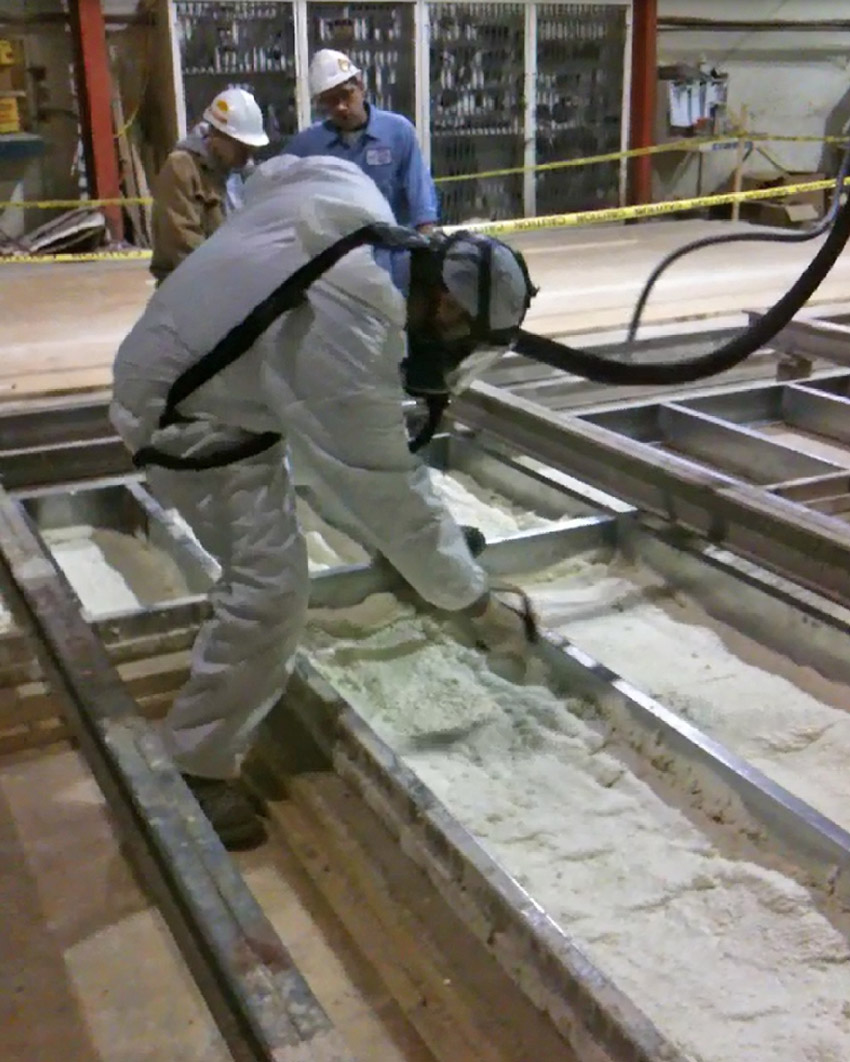
© SlenderWall by Easi-Set
Factory-applied foam insulation seals the air gaps and provides the guarantee of a quality thermal wall system.
Innovative 21st Century Walls
Scientists believe that technology has changed our perception of time. Technology is expanding the ability to produce complex materials for the construction market in shorter time periods. It has both provided an impatient market for timesaving construction as well as produced a solution to the creation of “instant buildings.” Project owners and project teams are increasingly facing shorter schedules and tighter budgets.
Comparing old and new precast panel systems, the early systems designed for use in European housing were heavy and not necessarily factory controlled. According to the authors of the Postwar Building Analysis website:
“Although each system had its particular features, there were nevertheless some general characteristics most heavy prefabrication systems shared. Typically, a system consisted of a fixed set of panels for facades, floors, and inner walls, as well as prefabricated staircases. The panels were up to 8 meters long (or the width of one room) and were between 6 and 30 centimeters thick. The production process was highly mechanized. The panels were usually cast horizontally in steel molds. Reinforcement bars and hooks or other features to facilitate transporting, handling, and joining the panels were provided beforehand, as well as frames for doors and window openings. Different kinds of concrete could be used, in some cases layered within the same panel depending on its function. A panel’s insulating capacity could be enhanced by adding an internal layer of insulation. Once cured and completed with surface finishes, the panels were transported to the construction site and placed in position. The metal hangers and protruding reinforcement bars were interlaced, and the joint was filled with concrete.”12
Innovative 21st century lightweight precast concrete wall systems are the culmination of the visions of early design professionals. They desired a system that would provide a fully tested performance while shortening the construction process. Tom LePage of Barr & Barr, project engineer for the Huntington Hospital, sums it up by stating his appreciation for a fully tested performance. “Our overall objectives of design flexibility, sound construction, and speed of building erection—all at economical costs—were made possible with the modular lightweight precast panel system,” he says.
These wall systems can be selected for climate zones ranging from hot and humid to extreme cold. Originally developed in the United States as a lightweight alternative to low brick and block commercial building, the growth of this industry has provided new opportunities for economic, efficient, sustainable, and resilient buildings.
End Notes
1Energy Flows & Energy Future. Top 10 Projects. The American Institute of Architects. Web. 7 Feb. 2018.
2New Orleans BioInnovation Center Built With Innovative, Lightweight Precast. SlenderWall. 2 Jan. 2013. Web. 8 Feb. 2018.
3Building Performance Database. U.S. Department of Energy. Web. 8 Feb. 2018.
4USACE Army LEED v4 Implementation Guide. U.S. Army Corps of Engineers. September 2014. Web. 9 Feb. 2018.
5Baltimore City Green Building Standards Volume 1: Regulations Manual. TerraLogos Eco Architecture. 2010. Web. 10 Feb. 2018.
6“Over-Cladding for Thermal Performance and Building Resiliency.” Buildings XIII Conference. Ayers Saint Gross. December 2016. Web. 10 Feb. 2018.
7Design Standards. Cleveland Clinic. 2013. Web. 11 Feb. 2018.
8“Alternate-Cladding Value Is More Than Skin Deep.” Commercial Architecture. 26 Jan. 2017. Web. 11 Feb. 2018.
9IBID.
10Ross, Chuck. “Luxury Project Showcases Precast’s Design Flexibility.” The Concrete Producer. 26 Oct. 2017. Web. 11 Feb. 2018.
11IBID.
121945–50. Post-War Building Materials. Web. 11 Feb. 2018.
Celeste Novak is an architect and author whose Michigan practice focuses on sustainable and universal design. www.linkedin.com/in/celestenovak

|
SlenderWall is a high-performance, thermal- and fire-code compliant, architectural precast composite envelope system. Reduce structural costs and on-site trades while increasing installation speed with the only product that combines lighter weight, durability, versatility, beauty, and performance in one package from outside skin through integral interior steel stud wall. www.slenderwall.com
|
Originally published in Architectural Record
![]() Continuing Education
Continuing Education













